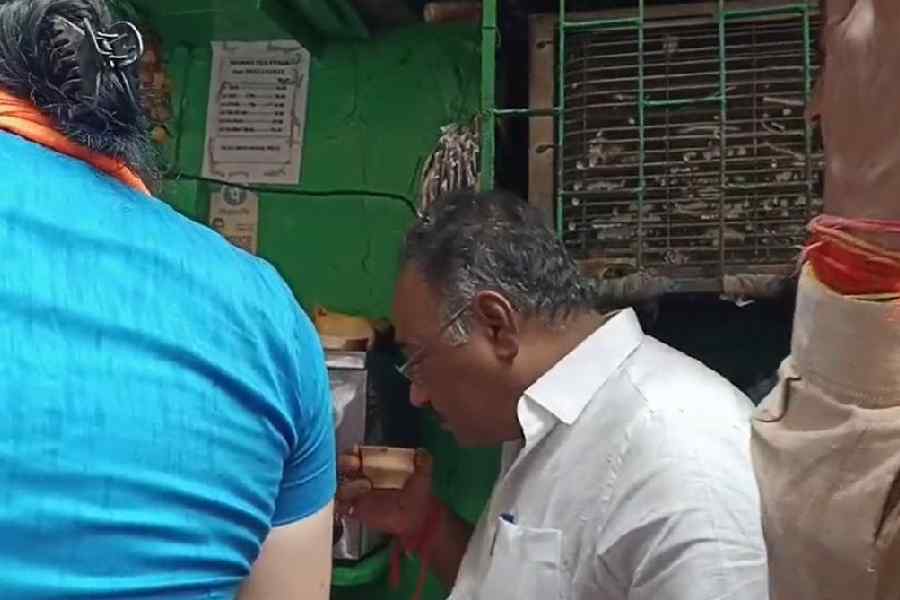

The banks of the Kestopur Canal, from Ultadanga to Kestopur, now resemble a barren wasteland.
Earth movers and trucks carrying construction materials line the bank while workers brave the blazing sun to lay concrete blocks to construct a walkway along the canal.
Several large sawn-off tree stumps stand as witness to the “development” that has done away with scores of fully-grown trees.
Residents of Salt Lake as well as Lake Town and Bangur Avenue recall that the stretch used to be shady not so long ago, thanks to the dense green cover.
The Telegraph Salt Lake had reported in the edition dated June 5, 2015 how scores of fully-grown trees, mostly Sirish (Albizia lebbeck), were dying mysteriously in Salt Lake and on VIP Road.
Experts had opined that it was due to parasitic attacks by Kerria Lacca insects that sucked all nutrients of the host trees and killed them. The lac produced by these insects is highly valued in the market for a variety of uses. Some of them had also suspected foul play, alleging that these insects were deliberately introduced to the trees for getting the lac.
Plan of action
In countless campaign speeches before the Assembly elections, Sujit Bose, the sitting MLA of Bidhannagar who is seeking re-election on a Trinamul Congress ticket, had announced that the bank of the Kestopur Canal would be beautified.
He shared his plans with The Telegraph Salt Lake. The entire bank will have a walkway that, according to him, would allow morning and evening walkers an uninterrupted stroll much like the beautified stretch on the Lake Town side of VIP Road, called Eco Nest, leading to the airport from Ultadanga.
The walkway will be created by placing interlocking paving stones, atop a layer of loose sand, of the kind now seen on several Salt Lake pavements. The entire stretch will be lined with benches.
Vegetation in the area would include palm trees, ornamental plants as well as several varieties of flowering plants. A hedge will also run along the edges of the canal.
A variety of statues will be placed along the walkway and the edges of the banks of the canal.
At least, three types of landscape lights, including trident lights, post lights and bollard lamps, will be used to light up the area.
The stretch will also have a number of food kiosks.
“The idea is to transform the banks. Earlier this area was overrun with weeds and a garbage dump. People were scared to venture this side after dark. We believe in development and everyone will be surprised once the work gets done,” Bose told The Telegraph Salt Lake.
Apart from the beautified garden and walkway, a service road from the airport to near the base of the Ultadanga flyover will be constructed.
The project cost for this has been pegged at Rs 32 crore, out of which the irrigation department that owns the canal bank has already paid Rs 9.52 crore, said informed sources.

Fond memories
But the beautification plan is coming at the cost of the existing greenery. The banks used to be lined by rain trees, particularly Sirish and Babla. A variety of shrubbery also grew here. With a water body beside them, the trees attracted a lot of birds.
“Every evening, the chirping of birds would liven up our living rooms. Since our house overlooks the canal we could often see birds like kingfishers and storks clearly from our windows,” said Amitava Bhattacharya, a resident of AD Block.
Apart from the birds, the banks would be a regular habitat for a variety of reptiles and small mammals.
Several residents of Salt Lake also recalled instances when civets had been spotted.
“The bank that is being beautified used to be part of a green corridor on VIP Road. Apart from the shade, the trees offered shelter to a large number of birds,” said a forest department official.
According to the official, some of the trees had been planted almost four decades back.
“The forest department undertakes plantation drives and the trees on both sides of the canal bank bordering Salt Lake were planted in the 1970s. That was one of the first drives in this part of the city. Later, many trees were added in phases,” the official said.
Killing field
The entire stretch now wears a ravaged look. As earthmoving machines dig up sand from the beds of trucks and dump them on the banks, several dead trees still stand in the backdrop, branches barren of leaves, next to some living ones which are equally threatened by the axe.
The trunks of chopped trees lying about bear testimony to the fact that the “beautification” project is actually taking shape over a killing field.
As one moves towards the airport, several old shells of JNNURM buses stand parked. Further down the road, where the VIP Road flyover ends, a garbage dump has piled up.
In the entire stretch of the road, once lined with scores of trees, not a single live tree can be spotted.
“Till a few years back this stretch was green. Now it resembles an urban desert,” said Krittika Agarwal, a Salt Lake resident who works in an airline and takes this route daily to work.
Death trap
This particular stretch has been making headlines for the death of trees for several years.
According to green activist Subhas Dutta, foul play was first suspected about eight years back when an outdoor advertisement agency had allegedly poured acid on tree trunks.
In 2009, another activist recalled several trees being damaged when the canal was being dredged. “The soil that was dredged out was senselessly piled up on the tree trunks,” added Abhishek Choudhury, who stays in AE Block.
Another setback for the trees was when the pipeline from the Chitpore Lockgate to the New Town water treatment plant was being laid. As a result of the extensive digging, the root network of several large, old trees got damaged, said Dutta.
The final blow was struck when the remaining trees in the area died after turning pale white last year.
“Look at the area in which Elliot Park has come up on Chowringhee Road in central Calcutta. It boasted of more than 100 trees. One fine day, the government decided to have a park there. The end result is soothing to the eye but detrimental to the environment. Fully grown trees generate much more oxygen and absorb carbon dioxide than the varieties found in urban gardens like Elliot Park. The government is again making the same mistake by replacing the green cover along the Kestopur canal with ornamental plants,” said Dutta.

Smelling a rat
Residents and a section of forest officials alike suspect that a nexus of foresters, civic body officials and timber mafia are behind the attack on the green cover. The trees were being chopped off as they were proving to be a hindrance to the beautification plan, they allege.
“Rather than hack live trees and face the flak, it makes more sense to simply kill them first and then hack them. We are not convinced that so many trees suddenly died on their own and within months, the MLA announces a beautification project right where they stood,” said a resident of IA Block.
A series of development projects was already posing a threat to the VIP Road trees before the MLA played his beautification card.
According to a forest department official, the public health engineering department had taken permission to fell trees to lay the water pipeline.
More recently, the public works department that is constructing the service road took permission to fell 519 trees in the area. Of them, residents claim 40 trees have already been hacked.
“Any project that requires the felling of trees has to be cleared by us first. The rule is the agency has to rather plant five trees for every tree felled or plant trees in 20 per cent of the area where the project is being carried out. We only give them a go-ahead after calculating which of the above comes to more number of trees,” said divisional forest official, utilisation division, Subrata Bandyopadhyay.
Most of the trees that died recently are Sirish, which is classified as a rain tree and has an average life span of 70 years. A full-grown tree absorbs 28.5 tons of carbon dioxide annually, as per a study by the School of Forestry of the Bogor Agricultural Institute, Indonesia. It has medicinal properties too and is suitable for making furniture.
Environmentalist Dutta warns that only 1 per cent of Calcutta is under green cover.
“There should be no development work undertaken by sacrificing trees. Abroad, and even in Indian cities like Delhi, pavements and boulevards veer around trees. It is only in Calcutta that they are hacked mercilessly even if they don’t pose a challenge to the project,” added Dutta.
The beautification project, he asserted, could have and should have been inclusive of the existing vegetation, particularly the trees in the area.
Should beautification take place by killing trees?
Write to The Telegraph Salt Lake, 6, Prafulla Sarkar Street, Calcutta 700001. Email: saltlake@abpmail.com










